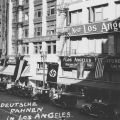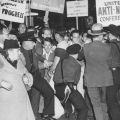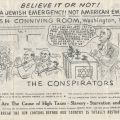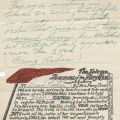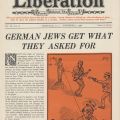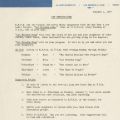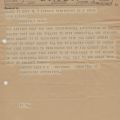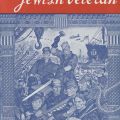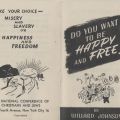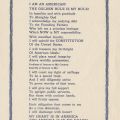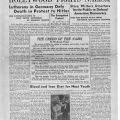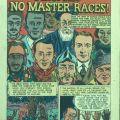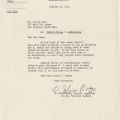In the history of the United States, religious freedoms guaranteed by the First Amendment have frequently come under fire. In the 1920s, the rise of the Ku Klux Klan in concert with restrictive immigration legislation, educational prohibitions, and economic scapegoating, resulted in growing anti-Semitism against Jews. By the early 1930s, a worldwide economic depression was in full swing, and in combination with the rise of German Nazism, Jews experienced increasing prejudice in the United States.
 In Southern California, local Jewish leaders and their allies responded by forming a special defense organization known as the Los Angeles Community Relations Committee, later the Jewish Federation Council of Greater Los Angeles, Community Relations Committee (CRC). The CRC's purpose was to work with the Anti-Defamation League, B'nai B'rith, the American Jewish Committee, the American Jewish Congress, the Council of Jewish Women, and other Zionist organizations to fight anti-Semitism in the United States. The Jewish Federation Council of Greater Los Angeles, Community Relations Committee Collections documents the organization’s efforts to combat anti-Semitism and educate the public through cooperation with both Jewish and non-Jewish groups. The collections are divided into three parts: Part 1 (1921-1937), Part 2 (1920-1950), and Part 3 (1933-1951).
In Southern California, local Jewish leaders and their allies responded by forming a special defense organization known as the Los Angeles Community Relations Committee, later the Jewish Federation Council of Greater Los Angeles, Community Relations Committee (CRC). The CRC's purpose was to work with the Anti-Defamation League, B'nai B'rith, the American Jewish Committee, the American Jewish Congress, the Council of Jewish Women, and other Zionist organizations to fight anti-Semitism in the United States. The Jewish Federation Council of Greater Los Angeles, Community Relations Committee Collections documents the organization’s efforts to combat anti-Semitism and educate the public through cooperation with both Jewish and non-Jewish groups. The collections are divided into three parts: Part 1 (1921-1937), Part 2 (1920-1950), and Part 3 (1933-1951).
The committee, made up of about forty representatives, adopted the strategy set forth by the Anti-Defamation League for combating "un-Americanism," namely to infiltrate and expose pro-Nazi and anti-Semitic organizations and turn the information over to federal government agencies. The CRC met on a biweekly basis to set policy and report on right wing activities in Los Angeles. Undercover agents and informants were recruited from the American Legion and Disabled American Veterans, and planted among suspect groups in the Los Angeles area. The Committee collected a massive amount of propaganda, primarily from anti-Semitic, pro-Nazi, and other right wing organizations. The Americanism Committee of the Los Angeles County Council of the American Legion presented information gathered by the CRC to the House Un-American Activities showing the connections between local groups including the German-American Bund, Friends of the New Germany, and the German government in Europe.
With the United States' entry into World War II, the committee's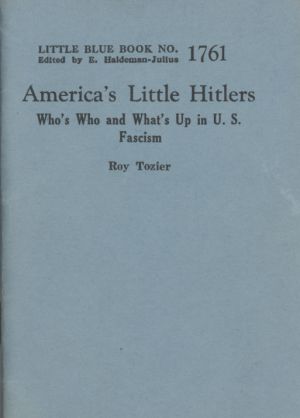 intelligence gathering activities and investigative journalism were superseded by new activities with patriotic organizations, veterans groups, inter-faith religious organizations, and local schools and colleges to combat rising bigotry and discrimination. The committee also worked closely with national Jewish groups such as the American Jewish Committee and United Jewish Welfare Fund to fight the Nazi threat, to coordinate Jewish civic defense activities nationwide, and to combat anti-Semitism through education and wide-scale dissemination of literature promoting religious freedom.
intelligence gathering activities and investigative journalism were superseded by new activities with patriotic organizations, veterans groups, inter-faith religious organizations, and local schools and colleges to combat rising bigotry and discrimination. The committee also worked closely with national Jewish groups such as the American Jewish Committee and United Jewish Welfare Fund to fight the Nazi threat, to coordinate Jewish civic defense activities nationwide, and to combat anti-Semitism through education and wide-scale dissemination of literature promoting religious freedom.
Some of the most important issues the CRC addressed in the post-World War II period included resettlement of refugees from Eastern Europe on the West Coast, de-nazification in Germany, immigration legislation, religion in public schools, communism, civil liberties, discrimination in housing, fair employment practices, inter-racial relations, stereotyping in the motion picture industry and religious tolerance.



